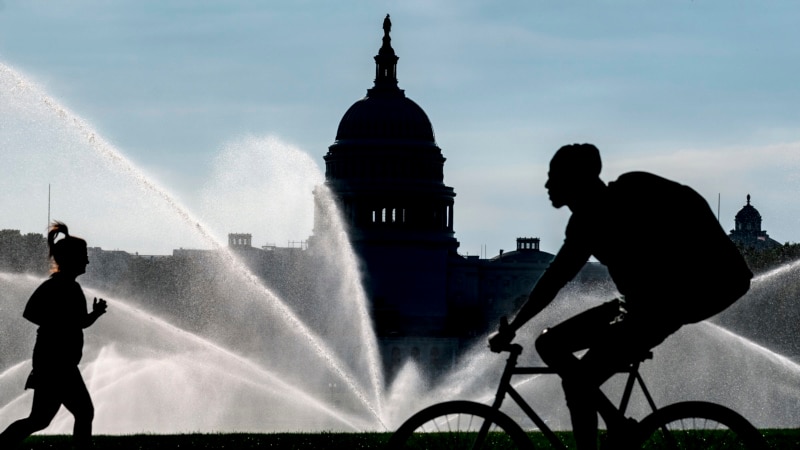The media and social networks as information platforms play a key role in the perception of a deeply polarized United States, magnifying feelings of division already present among voters ahead of this year’s presidential elections.
Scholars, politicians and voters maintain conflicting opinions on whether news coverage and digital content influences the opinions of a country that from afar shows deep divisions according to political affiliations and that seem irreconcilable.
But are the media and the way news is consumed really to blame for the apparent extreme polarization in the midst of a historic election in the United States?
“The media, whether traditional or social, plays a role in polarization… When you need the clicks, there is an incentive to be more extreme because that will attract more attention,” he told the Voice of America Justin Owen, president of the Beacon Center, a think tank based in the southern state of Tennessee.
Owen explained that when you present people with the main issues of an election, such as abortion, guns, immigration or the economy, they will respond according to the options presented. However, “they do not ask questions when conducting surveys about topics that impact people’s daily lives.”
“If you ask people about things that lie beneath the surface, you will get different results and you will find opportunities to unite… Social media is certainly not prepared for that… even traditional media, in general, generates greater polarization because it is “This self-fulfilling prophecy of asking what do we think matters and let’s put it more in front of you,” he added.
For Syracuse University Political Science professor Johanna Dunaway, the media helps intensify this gap or at least the feeling of division, “but they are definitely not causing it.”
“Polarization was happening before the shift in media and the resurgence of ‘partisan news.’ (…) There is evidence, for example, that suggests that when the media constantly covers how polarized everyone is, that tends to increase the perception that people are polarized,” he told VOA.
What do Americans say?
Nearly three-quarters of American adults say the media is increasing political polarization in the country, according to a 2023 survey by The Associated Press and the Robert F. Kennedy Human Rights Center, which also recorded that almost half of those surveyed said they had little or no confidence in the media’s ability to report “fairly and accurately.”
A small majority of Americans said they had some level of confidence, while only 16% expressed a lot of confidence. 45% stated that they trust half or not at all what the American media reports.
“We know that trust in the media is on the decline and has been that way for a long time in the US. And I think one of the reasons is that a particular party has been gradually increasing its criticism of the dominant or mainstream media,” said Dunaway, who also assured that political affiliations have a lot to do with this.
According to the study of AP and the Robert F. Kennedy Human Rights Center, who identify with the Republican Party view the media less favorably than Democrats. 61% of Republicans believe that the media damages democracy, compared to 23% of Democrats and 36% of independents.
Among Republicans, “trust in the media declined earlier and is lower than among Democrats. And that is partly because the elites within the party have been attacking the press for quite some time,” explained the Research Director of the Institute for Democracy, Journalism and Citizenship at Syracuse University.
“I think there is a lot of noise and confusion in the media environment, and that will probably create a lot of uncertainty for a lot of people and continue to erode distrust during the election cycle,” he warned.
The abyss is not as big as it seems
Many who do not trust traditional media tend to move to social media as their primary source of information. The problem with this change is the veracity of the news on these platforms, which in turn fuels division.
“Many sources on social media should not be trusted. (…) With more and more sources of misinformation trying to masquerade as real media, it is becoming increasingly confusing for the average news consumer to try to tell the difference,” Dunaway said.
John Geer, a professor at Vanderbilt University in Tennessee, said that social networks “give voice to the extremes,” which feeds “the feeling that things are more polarized than they really are… we tend to “That members of the media like to focus on the disagreement rather than the agreement,” he added.
Current platforms, through algorithms, allow people to receive information only from the side of the spectrum that interests them, which according to experts, reinforces the difference in opinions.
“These days, you can live in a vacuum on the left or the right, and not really be exposed to the ideas of the other side if you don’t want to. That makes it easier for people to put their heads down and decide not to listen to anyone else,” insisted Justin Owen.
Pilar Kelly, a young Democratic voter from North Carolina, said she feels that through these platforms, people are made to “believe that the opposite party doesn’t like us” beyond political ideals, which “reinforces animosity.”
On the other hand, for Zeenath Abplanalp, president of the Republican Women organization of Charlotte, North Carolina, “the country is not as divided as it appears in the media.” Abplanalp assured that regardless of priorities, Americans seek “prosperity, good education for their children and security.”
Johanna Dunaway agrees with this. The gap between Republicans and Democrats is not as abysmal as it is believed. “Those are erroneous perceptions,” remarks the professor, who attributes many of these opinions to ignorance. “If they knew each other’s preferences, maybe they would realize that on policy issues they are not so far apart.”
“When you focus on specific issues and ask people in the audience basically what they think about different issues and their positions on them, or even if they have different political preferences, they are not as divided as polarization estimates would lead one to believe,” he concluded.
Connect with the Voice of America! Subscribe to our channels Youtube, WhatsApp and to newsletter. Turn on notifications and follow us on Facebook, x and instagram.
















Add Comment